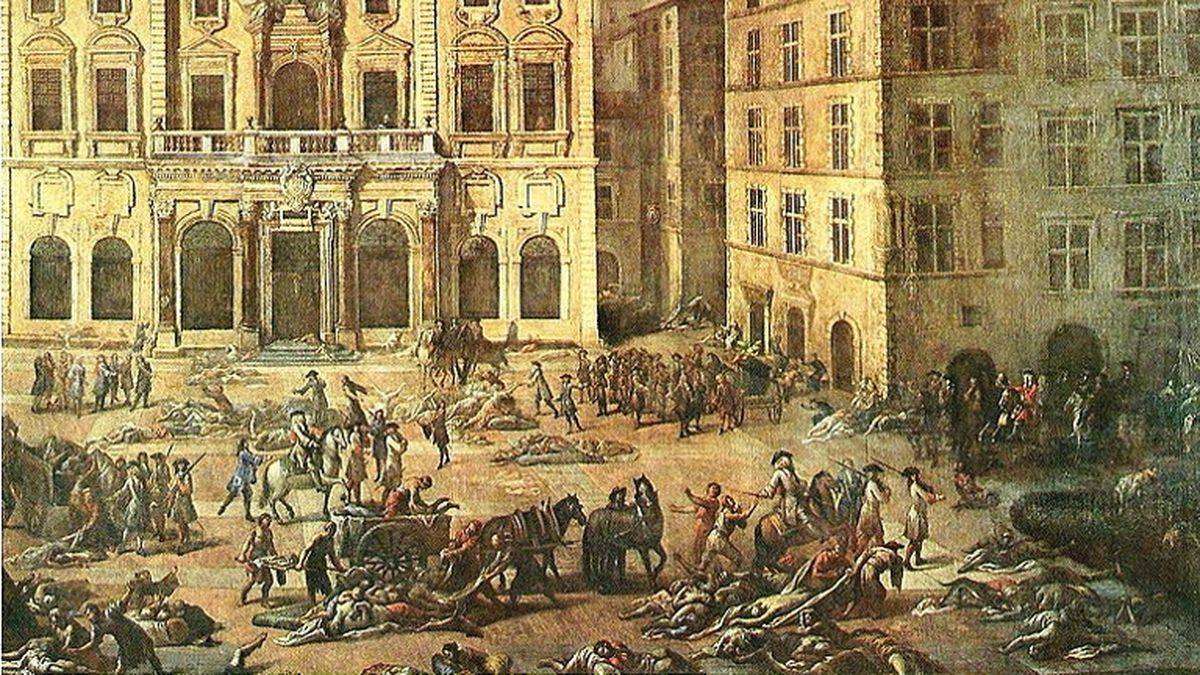 The plague in Marseille by M. Serre | ©Robert Valette / CC-BY-SA
The plague in Marseille by M. Serre | ©Robert Valette / CC-BY-SAA plague on us...
The plague epidemic hit Marseille between June 1720 and December 1722.
60 communes of Provence were contaminated. 50 000 people from Marseille died (they were 100000 in the beginning).
The plague hit Marseille but also contaminated all Provence area!
It was the last big plague epidemic registered in France. And we know today the tragedy could have been avoid...
The column
Anyway, the column dates back to 1802, made by sculptor Chardingy and architect Desfougères.
Do you see the little child at the top of the column? It’s the Genius of Immortality, symbolizing all those people who died helping sick persons...
A boat from Orient
Everything was OK
Our story begins with a boat, the Grand-St-Antoine, sailed by captain Chataud. He left Syria with nice fabrics on board.
The boat left with a ″patent clean″, a letter saying there was no plague on board!
So, everything was OK? Because, in Damas, a plague epidemic had just begun! But, well… come what may!
Hecatomb and Corsican premonition
Now, they had to go to Marseille. After few days of travel, the captain stopped to take 2 Turkish on board… who strangely died after few hours.
The two sailors who threw their bodies in the sea also died few days after…
Whoa, pretty weird! After, it was a real hecatomb. The crew dropped like flies!
″Pestilential fever″, said the doctor (who also kicked the bucket)…
So nothing to see with the terrible plague? But the captain (hidden in the stern, well, well, well) kept going.
They arrived near Cagliari, Corsica. But people stopped them!
Do you know why? Because of their governor’s nightmare! He dreamt his island was completely devastated by the plague! So he ordered to push back all the boats, at any cost…
Island people rebelled, but later, they would learn this damned boat carried the plague… What a relief!
The arrival in Marseille
Unloading!
In short! The Grand-St-Antoine arrived in Marseille in May 25th 1720.
When they asked if things were OK, the captain only said 8 men died, because of ″a bad feeding″.
Well: at that time, when suspect deaths happened on a boat, they used to put the aforesaid boat on quarantine, on the island de la Jarre: a rocky island located near Marseille.
Then, the Health Office of the city had to control the crew and the goods. But here, they immediately unloaded the goods (expensive fabrics, about 300000 livres, a big sum) in the infirmary, located near the Vieux-Port.
The disease hit
No precaution! Then, several sailors passed away. But who cares?
Anyway it was too late: they had unloaded fabrics… And sailors robbed those fabrics to sell them in the city, in the poor districts.
All these fabrics were of course infected, because full of fleas… OK, now, beware: the plague was here, in Marseille!
The plague spread!
First victims
The first victim was Marguerite Dauplane, who fell sick on June 20th.
Then, on 28th, it was the turn of the family Creps. On July 1st, Mrs. Eygasière and Tanoux died, and so on. They buried the bodies under a coat of quicklime.
But authorities never talked about ″plaque″! No, it was something else, everyone had to calm down… Even when doctors found ganglions under the sick persons’ armplits (typical sign of the disease), the city mayors swore that there was no risk of contagion...
But when two doctors (Peyssonnel father and son) came to examine a sick kid, the news fell: it was the PLAGUE!!
In July 20th 1720, we had 23 deaths per day! Imagine: the city was empty, the streets deserted, with only the scary sound of the dying persons’ rale...
Death, the only outcome
So, they took measures, but it was too late… They had to remove all the corpses and cleaned up the houses, quick!
The rumor of a terrible epidemic spread and the panic hit Marseille.
Some tried to run away from the city, but, they were already contaminated, so they began to spread the plague outside, in Provence!
On July 31th, mayors forbade communication between Marseille and the rest of the country. Confined, people started to starve, because of the lack of supplying...
Undertakers turned up
In August 1720, doctor Sicard announced people had to light fires with sulphur, in the streets, to eradicate the disease: a catastrophe!
The black smoke, the heat and the lack of wind contributed to develop the plague. In August 1720, 50 people died every day, then 100, then 500!
Streets were full of cadavers, it was horrible. They decided to put them in churches’ crypts, under flagstones sealed with melt leaden.
Huge common graves soon appeared everywhere. But it wasn’t enough… Even undertakers died!
They needed culprits!
In the beginning of September 1720, captain Chataud was locked in jail, in the castle d’If, waiting for his trial: he was found guilty for the epidemic, he and his cursed cargo!
But, by the way… what about Chataud and his freight?
Were they really responsible of this catastrophe? No! The fault came from city mayors. A period document told about a secret conversation between the captain and the mayor Jean-Baptiste Estelle…
This last one owned a great part of the precious cargo! He knew for the plague, but unloaded the cargo, even so! He ignored the quarantine! He just wanted to sell his precious fabrics in Provencal fairs…
So, that was why Chataud declared he had no suspect deaths on board!
The captain stayed 3 years in jail: he officially was held liable for this tragedy. Finally, they succeeded in eradicating the plague, especially thanks to men like chevalier Roze, who helped a lot cleaning the infected districts.
In December 1722, the epidemic definitively left the city...
